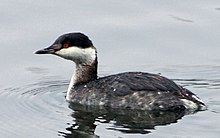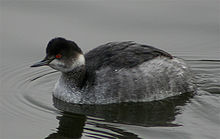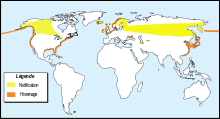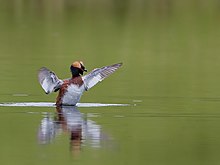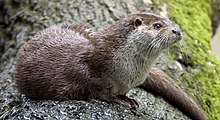Ear grebe
| Ear grebe | ||||||||||
|---|---|---|---|---|---|---|---|---|---|---|

Ear grebe in magnificent dress |
||||||||||
| Systematics | ||||||||||
|
||||||||||
| Scientific name | ||||||||||
| Podiceps auritus | ||||||||||
| ( Linnaeus , 1758) |
The Horned Grebe ( Podiceps auritus ) is a species of bird from the family of grebes (Podicipedidae). Its distribution area extends over northern Europe, northern Asia and northern North America . It is the only grebe that also breeds north of the Arctic Circle . In the north-east of Central Europe there are a few breeding occurrences of this species. In Central Europe it is also regularly observed in small numbers as migrants and winter visitors. He then wears his simple dress, in which he can easily be confused with the black-necked grebe, which is more common in Central Europe .
Appearance
Ear grebes have a body length of 31 to 38 centimeters. They are therefore significantly larger than the little grebe and have a less stocky build and a longer neck than these. The males are on average slightly larger than the females. In the males, the hand wings are between 13.2 and 16.0 centimeters long, the beak measures between 2.0 and 2.7 centimeters from the forehead fletching to the tip and they weigh between 320 and 570 grams. Females have a wing length between 12.4 and 15.3 centimeters, their beak is 1.9 to 2.5 centimeters, slightly shorter than that of the males. Females weigh between 300 and 430 grams in the winter months. The overall gender dimorphism is so low that it does not allow any field ornithological distinction between the sexes.
The beak is blue-gray to black in both sexes with a flesh-colored base and a light, almost whitish tip. The plumage on the top of the head is tight-fitting in the ear grebe. The iris is intensely red during courtship and pink during rest. The pupil is surrounded by a narrow, silver-white ring. The legs are gray, the feet blue to blue-green. The legs start far behind the body.
Splendid dress
The magnificent dress is characterized by a glossy black, and in rare cases also matt black, head plumage with spreadable tufts of feathers on the head sides. These tufts of feathers or ears are noticeably yellow-red and consist of long, narrow feathers between the eye and the back of the head. The tufts of feathers are somewhat more pronounced in the male than in the female. The black feathers on the side of the throat and the cheeks are also greatly elongated and can be spread apart. A narrow, red-brown rein stripe runs from the end of the beak to the eye. The neck is reddish brown in front and on the sides, the nape is black. The front chest, the sides of the chest and the flanks are red-brown, the underside of the trunk is white. The white underside of swimming birds is usually not visible. The back plumage is black, the individual feathers are lined with gray. The wings are brown and have lighter inner flags with a white base. The under wing coverts are white.
The ear grebe wears the eye-catching headdress only in spring. From around mid-June, after a partial moult , the birds have a summer headdress in which the tufts of feathers are significantly shorter and less colored. From mid-July the white cheeks begin to develop, which are characteristic of the simple dress. It is usually the female who does this moult first. In the male, this change takes place about a month later.
Plain dress
The simple dress worn in autumn and winter is predominantly black and white with a black top of the head and white cheeks. The back and the back of the neck have dark plumage. This dark fletching is narrowest on the upper neck. The fore neck is predominantly white. Adult birds occasionally have small black spots on their throats. At the transition from the neck to the front breast, the plumage is washed out brownish.
The head drawing is rich in contrast in the ear diver even in the plain dress. In adult birds, the pure white cheeks are sharply defined from the dark skull, the dividing line runs at eye level. The white of the cheeks extends almost to the back of the head, so that an almost closed white neck ring is formed. There is also a small white feather section above the rein strip, which extends from the base of the beak to the eye.
Chicks and young birds
The downy dress of newly hatched chicks has a characteristic striped pattern. On the upper side of the body, wide, dark gray to black stripes alternate with fine white vertical stripes. The black and white stripes are equally wide on the head, neck and chest. On the lower sides of the head, the black stripes are interrupted and appear punctiform. This distinguishes the chicks of the eared grebe from those of the crested and red-necked grebe , which otherwise have a very similar stripe pattern. The young birds have a bare spot on their head, which glows reddish when excited. The iris is orange-brown. The beak is pink with a white tip. On the upper beak, the downy cubs have two black cross bars, while the lower beak is without drawing. Legs and toes are blackish gray. The swim lobes of the toes have a flesh-colored hem.
The stripe pattern on the top of the body disappears in the first few weeks of life. However, young birds retain the stripe pattern on their head and neck that is characteristic of the species during their first months of life. They then change to a youthful dress that resembles the plain dress of adult birds. The dark feathers appear browner overall. The first splendid plumage that the young birds wear often has black-brown plumage instead of the otherwise blue-black head plumage. The characteristic tufts of feathers and the elongated feathers on the sides of the head are not yet formed. Young birds only switch to the plumage of adult birds towards the end of their second year of life.
Possible confusion with other bird species
The ear grebe can be confused with the almost equally large black-necked grebe. Compared to this, the beak of the ear grebe is more compact and straighter. The black-necked grebe, on the other hand, has a slightly raised beak. The head profile is also different. The black-necked grebe has a steep forehead, while the eared grebe has an only moderately rising forehead because of the flat feathers on the top of the head.
The eared grebe and black-necked grebe are very similar in their simple dress. In addition to the different beak shape and the steeper forehead, the black-necked grebe can be recognized by the smooth transition between the dark top of the head and white cheeks. This makes the cheeks look grayer overall.
voice
Horned grebe are generally not very loud and can be heard mainly during courtship. They emit soft trill calls, which can be onomatopoeically rewritten as dji-ji-ji… ji-jrrr and are reminiscent of the calls of the dwarf diver. A nasal aaanrr with a sloping pitch serves to lure the partner bird during the courtship season. The manner of calling is so different that individual birds can be differentiated. The pitch fluctuates depending on the situation. The alarm call is similar to the lure call during courtship, but has a higher pitch. The calls are also higher and more choppy when dealing with conspecifics. The trill calls during mating, on the other hand, are faster, more even and deeper.
distribution
Breeding area
Horned grebes have a patchy circumpolar range. Their breeding areas are mostly between 50 ° and 65 ° north latitude. In northern Europe, eared grebes breed in northeast Norway , northern and central Sweden, Finland , Estonia , the Faroe Islands , northern Scotland and Iceland . The breeding area extends from Russia eastward over Siberia to the mouth of the Anadyr and to Kamchatka . In a southerly direction they reach the southern border of the Urals and the Amur .
In Central Europe, the eared grebe is exceptionally breeding bird in the extreme northeast. Several breeding records are available for Poland from the last few years. In 1981, a breeding pair was established in Schleswig-Holstein, which had successfully brooded twice by 1987. A second breeding pair had seven successful broods between 1988 and 1999 in annual breeding attempts, from which a total of 16 young birds emerged. Since 1999 there has been a second occurrence with one or two breeding pairs as well as oversummer and courtship in a third place. A stronger spread in Central Europe is currently not expected due to population decline in the Baltic region, but the current breeding success seems sufficient to stabilize the occurrence in Schleswig-Holstein.
While ear grebes are widespread in Alaska and western Canada , in eastern North America only near Québec is there a small, isolated breeding population of five to fifteen breeding pairs. These genetically differ significantly from the rest of the North American populations and are presumably descendants of European breeding birds that ended up as wanderers after wintering on the coast of southwest Greenland.
wintering
The individual populations of the eared grebes do not show any uniform migration behavior. They are broad front pullers who often only cover short distances by train. Some European populations, for example, migrate in a westerly direction to the nearest ice-free coastline, while others move in a southerly direction. The Scottish populations overwinter mainly in their breeding area. Wintering ear grebes can be found on the coasts of Ireland, the Atlantic coast of Spain and in the southwest of Greenland and in the northwest of Norway. Occasionally they stay there in winter north of the Arctic Circle. There are also large overwintering populations on the coast of the Baltic Sea . The first winter guests will arrive on both the North and Baltic Sea coasts from the end of August. Parts of the northern European breeding populations move south through the inland and can then also be observed on larger inland lakes and rivers. In the Mediterranean area, eared grebes overwinter mainly on inland waters of Turkey .
The wintering areas for non-European breeding birds include both the west and east coasts of North America, the Aleutian Islands and, in Asia, the coasts of Japan, the east coast of North Korea and China. The non-European breeding birds also sometimes stay on larger, ice-free inland waters in winter. Winter guests can be found on inland waters especially in the east of the USA down to the Gulf of Mexico . The Central Asian inland waters are also among the species' winter quarters. Occasionally, eared grebes also overwinter in India and Pakistan as well as on the Azores , Bermuda and Hawaii .
habitat
Grebes are breeding birds of the marshland and marshland as well as inland lakes. It is found as a breeding bird both in regions of the sub-arctic tree line and on mountain lakes. The latter is the case, for example, in the northwest of the USA and in the border region between Russia and China. For Kyrgyzstan there are breeding specimens up to altitudes of more than 3000 m .
A high settlement density can be observed above all in the transition zone between light deciduous or mixed deciduous forest and boreal coniferous forest . The ear grebe prefers small to medium-sized ponds or lakes in this region. On average, these inland waters have a size of 1.2 to 1.3 hectares. In regions where other species of grebes do not occur, they can also be found on oligotrophic , large lakes. Where they breed on larger inland lakes, they prefer to stay in secluded bays. Horned grebes seem to prefer waters where an open body of water is surrounded by low sedges and horsetail plants . Unlike black-necked grebes, they can also be found on almost vegetation-free crater lakes and raised bog lakes. It cannot be ruled out, however, that eared grebes are less frequently observed in nutrient- rich water areas surrounded by tall marsh plants, only because of the food competition with white -necked grebes and red-necked grebes . Grebes also occasionally breed on brackish lakes .
Food and subsistence
Horned grebes feed on smaller fish as well as insects and crustaceans . On average, you eat around 100 grams of food a day. Whether fish or insects and crustaceans make up the main part of the diet depends on the habitat. Fish play an important role in the diet of European breeding birds. Fish up to a length of ten centimeters are eaten. The most important food components of the Asian and North American birds, on the other hand, are crustaceans and aquatic insects.
On inland waters, eared grebes prefer to look for food in water areas that are between 0.5 and 2 meters deep and are densely overgrown with underwater plants. During the winter, when eared grebes can also be observed in coastal waters, they use depths of up to 20 meters for foraging. During this time they occasionally form small groups, which are often associated with scoter and velvet ducks.
Ear grebes mostly look for food by diving and are on average underwater for a maximum of thirty seconds. Often they are only submerged so shallow that their backs stay afloat. The dive into greater water depths is initiated by a powerful leap forward before you submerge your head and neck. This enables you to achieve a steeper immersion angle. Insects swimming on the surface of the water are picked, and flying insects are also snatched from the air. This behavior is particularly intensified when mosquitoes hatch.
Comfort behavior
Horned grebes spend most of the day swimming on the water. The legs, which are set far back, are largely adapted to life in the water. However, they are poorly suited for locomotion on land. Outside of the breeding season, they also spend the night sleeping on the water. The beak then rests on the left or right of the neck in the chest plumage.
Grebes regularly clean and oil their plumage. Plumage care takes place floating on the water. The most noticeable movement in plumage care is the moment when you turn on your side in the water to clean the silvery-white underside of the body. Loose feathers are removed and usually also eaten. When ear grebes lead young birds, they also offer them feathers for food. This behavior is characteristic of all grebes. The feathers decompose in the stomach to a greenish, spongy mass that can fill up to half the stomach volume. Together with indigestible food residues , this mass is regularly regurgitated as a bulge . The usefulness of this unusual behavior is not yet fully understood. The spring mass probably prevents solid and sharp substances from entering the intestine. It probably also protects the stomach wall from injuries caused by bones. However, this behavior may also reduce the infestation by parasites that are mainly ingested with food.
Reproduction
The courtship
The ear diver is one of the species of grebes that has a complex courtship ceremony with a series of synchronous, dance-like movements of both sexes. The behavior of the courtship ceremony is not gender-related. All movements can be carried out by the female as well as the male.
The courtship ceremony is initiated by the birds calling one after the other with sloping, nasal aaanrr calls. One of the birds swims in the direction of the other partner, where it reappears several times on the surface. This sequence of movements ends when the bird emerges from the water only up to its neck, then slowly up to half of its chest. The back of the body remains submerged; The head and beak point away from the partner. The more inactive part of the couple "waits" with their necks bent back, the yellow tufts of feathers on the head ruffled widely and the wings raised and ruffled at the same time. If the two birds accept each other, the courtship ceremony turns into a synchronous swimming movement, in which both birds rise with their upper bodies out of the water. In this phase they turn to each other. The birds then slowly swim apart, dive for aquatic plants and present them in their beaks, while they swim parallel to each other for a distance of six to seven meters with their upper bodies partly raised high out of the water. Established couples in particular then show a triumphant swim, in which the wings are raised and spread apart, the tufts of feathers are bristled and the neck is bent far back.
Only couples who harmonize with one another show complete courtship. The courtship ritual is often already interrupted in the phase in which one of the ear-diver swims in the direction of the other partner, by a third ear-diver who swims purposefully between the advertising birds. These are mostly ear grebes that have already been mated. Birds of the same sex also begin the courtship ceremony with one another. However, the full courtship is never shown. Females swim apart again in the early stages of the ceremony. Fighting can occasionally occur between males who have previously bargained with each other.
During the courtship season, eared grebes are extremely aggressive. Among other things, diving attacks on other water bird species are carried out. It is documented that eared grebes drove a flock of much larger gray geese out of their territory by attacking them while swimming underwater.
Nest and brood
Ear grebes sometimes form a breeding and food territory similar to the little grebe, which is only defended by the male. However, ear grebes breed more frequently in small colonies.
The nest is occasionally built on the edge of the river bank vegetation, but is just as often on the open water, up to a meter deep. The nests rest on a substructure made of reeds and rushes and are buoyant. Often bent, dead stalks of the neighboring vegetation are built into the nest base or the birds use a small area of water that is densely surrounded by plants, so that the nest is prevented from drifting away. The actual nest is built from rotting leaves and spawn shoots and is often completely soaked. It is assumed that the putrefactive heat of the nesting material favors the brood. Both parent birds are involved in building the nest. The birds are able to build a nest suitable for a brood within twenty-four hours. Usually, however, nest building takes four to seven days. The finished nest can bear a weight of one to two kilograms.
The clutch consists of three to six eggs that are about 4.5 centimeters long and 3 centimeters in diameter. On average, only 63 percent of the eggs hatch young. However, eared grebes are able to attempt another breeding attempt a few days after losing a clutch. In individual studies it has been shown that females lay up to 50 eggs in one season after multiple clutch losses. However, once the young have been successfully brooded and reared, there is rarely a second attempt at breeding within the same year.
The females breed from the first egg laid. Both parent birds are involved in the brood, but the female breeds more persistently. The downy young hatch about three weeks after the start of breeding. They leave the nest immediately and are carried on their parents' backs for the first few days. After about four to five weeks they are independent. The young birds of a body of water often gather in so-called kindergartens and are fed there by all the adult birds.
Natural causes of death
Predators
The grebes' predators include pine marten , otters , red fox and wildcat as well as mink . Mink introduced from North America is believed to have had a major impact on populations in Scotland and Iceland. Predatory mammals prey on brooding ear-grebes at the nest and also eat the eggs. The large species of owls also hit ear-grebes when they sit on their nest. Flying ear grebes in particular are also threatened by birds of prey . In Iceland, for example, gyrfalcons successfully hunt eared grebes that fly from one body of water to another.
The eggs in the nest are also eaten by raccoons as well as gulls, ravens and crows.
Parasite infestation
Grebes, like all grebes, are heavily infested with endoparasites . Grebes are possibly the bird family with the highest levels of infestation with these parasites. This is due to their wide food spectrum, which includes numerous different aquatic insects. The endoparasites include tapeworms and roundworms . Ear grebes, on the other hand, are affected to a much lesser extent by ectoparasite infestations . Since they build their nests on floating platforms, the infestation by ticks , fleas and bed bugs is lower than with other bird species.
Systematics
External system
Grebes belong to the grebes family and are assigned to the genus of divers ( podiceps ) within this family .
Internal system
Usually two subspecies are recognized. The nominate form Podiceps auritus auritus is widespread in Northern Europe and Northern Asia as far as China. Podiceps auritus cornutus , on the other hand, is native to Eastern Siberia and North America. The back plumage of this subspecies looks rather grayish. In the magnificent dress, the tufts of feathers on the head are paler than in the nominate form and framed by gray-beige feathers.
The delimitation of a third subspecies Podiceps auritus arcticus in regions bordering the North Atlantic was proposed as early as 1822. As a distinguishing feature to the other subspecies, among other things, the significantly stronger beak was cited. However, this third subspecies is not currently accepted.
Duration
The western European stocks of the ear-grebe are relatively well studied. It is characteristic that the population fluctuates strongly and the number of breeding pairs can double within a short time. Overall, the number of birds of the nominate form Podiceps auritus auritus native to Europe and Asia is estimated at around 50,000 to 100,000 birds. The population of the subspecies Podiceps auritus cornutus, which lives in North America and Siberia, is more than 100,000 birds.
The ear diver is a species in Appendix I of the EU Birds Directive (RL 79/409 / EEC) for which bird protection areas are to be designated in the European Union.
In the Red List of Germany's breeding birds from 2015, the eared grebe is listed in category 1 as critically endangered.
Man and ear diver
Hunting
Like all grebes, eared grebes have very dense chest plumage that feels like fur. The use of rag bellows for the manufacture of clothing can be demonstrated for many cultures. Grebes were hunted particularly intensively in the 19th and (partially) up to the middle of the 20th century. Gloves, shoulder capes and muffs were made from the bird hide. The large divers such as the great crested grebe and racing divers were particularly affected by the hunt . There is no detailed information available on how severely eared grebes were affected by the hunt for their plumage or meat. For other grebes such as the black-necked grebe of equal size, it has been proven that they were used as food by indigenous peoples. It is therefore obvious that this also applies to the ear diver.
Changes in population due to environmental conditions
It affects potentially negative impact on the stock of the ears divers from when the breeding waters eutrophic . Ear grebes need relatively clear water with a dense vegetation of underwater plants. Nutrient enrichment often changes the composition of the respective fish population in the direction of the species that prefer to eat macroplankton. This leads to an enrichment of the water with microplankton, which makes the water unclear, which is why the population of underwater plants can be traced back to. Grebes are therefore affected by an intensification of agriculture, even if the breeding waters are not directly affected.
The pollution of the oceans with crude oil has a serious impact on the population of the ear divers . In 1976, 4,000 ear divers died in an oil tanker accident while they were wintering in Chesapeake Bay . Tanker accidents can have a significant impact on populations as eared grebes regularly overwinter in large flocks in the same region.
The eared grebe is considered to be one of the species that may be particularly affected by climate change. A research team that, on behalf of the British Environmental Protection Agency and the Royal Society for the Protection of Birds, examined the future development of the distribution of European breeding birds on the basis of climate models, assumes that the range of the ear-diver will change significantly by the end of the 21st century . According to this prognosis, eighty percent of today's distribution area will no longer offer the diver suitable habitats. The distribution area will, however, extend to Spitzbergen and also include the higher regions of Sweden and Norway, which are only sparsely populated by the eared grebe today.
literature
- Hans-Günther Bauer, Einhard Bezzel , Wolfgang Fiedler (eds.): The compendium of birds in Central Europe: Everything about biology, endangerment and protection. Volume 1: Nonpasseriformes - non-sparrow birds. Aula-Verlag Wiebelsheim, Wiesbaden 2005, ISBN 3-89104-647-2 .
- RS Ferguson, SG Sealy: Breeding biology of the Horned Grebe, Prodiceps auritus, in southwestern Manitoba. In: Canadian Field-Naturalist. Volume 97, pp. 401-408.
- Jon Fjeldså: The Grebes. Oxford University Press, Oxford 2004, ISBN 0-19-850064-5 .
- VD Il'ičev, VE Flint (ed.): Handbook of Birds of the Soviet Union. Volume 1: History of exploration, Gaviiformes, Podicipediformes, Procellariiformes. Aula Verlag, Wiesbaden 1985, ISBN 3-89104-414-3
- Günther Niethammer (Hrsg.): Handbook of the birds of Central Europe. Volume 1: Gaviiformes - Phoenicopteriformes. Academic Publishing Company, Wiesbaden 1966.
- RW Storer: The metazoan parasite fauna of grebes (Aves: Podicipediformes) and its relationship to the birds' biology. Miscellaneous publications of the Museum of Zoology, University of Minnesota no.188, 2000.
- Miklos DF Udvardy: National Audubon Society Field Guide to North American Birds - Western Region. Alfred A. Knopf, New York 2006, ISBN 0-679-42851-8 .
Web links
- Podiceps auritus in the endangered Red List species the IUCN 2008. Posted by: BirdLife International, 2008. Accessed January 31 of 2009.
- Videos, photos and sound recordings on Podiceps auritus in the Internet Bird Collection
- Ear Grebe's feathers
Single receipts
- ↑ a b c d e Fjeldså, 2004, p. 178.
- ↑ a b Niethammer, pp. 132-133.
- ↑ Fjeldså, 2004, p. 38.
- ^ A b c Collin Harrison, Peter Castell: Field Guide Bird Nests, Eggs and Nestlings. revised edition. HarperCollins Publisher, London 2002, ISBN 0-00-713039-2 , p. 37
- ↑ a b Niethammer, p. 133.
- ↑ a b Niethammer, p. 134.
- ↑ a b c d e Fjeldså, 2004, p. 179.
- ↑ a b c Bauer et al., P. 191.
- ↑ Ferguson and Sealy, 1983, pp. 401-408
- ↑ a b c Niethammer, p. 135.
- ↑ Fjeldså, 2004, p. 60.
- ^ Niethammer, p. 137.
- ↑ a b Fjeldså, 2004, p. 180.
- ↑ a b c Niethammer, p. 136.
- ↑ Fjeldså, 2004, p. 35.
- ↑ Fjeldså, 2004, p. 36
- ↑ Fjeldså, 2004, p. 82
- ↑ Fjeldså, 2004, p. 79.
- ↑ Collin Harrison, Peter Castell: Field Guide Bird Nests, Eggs and Nestlings. revised edition. HarperCollins Publisher, London 2002, ISBN 0-00-713039-2 , p. 36.
- ↑ Fjeldså, 2004, pp. 102 and 104
- ↑ Fjeldså, 2004, pp. 108 and 110.
- ↑ Fjeldså, 2004, p. 126.
- ↑ RW Storer: The metazoan parasite fauna of grebes (Aves: Podicipediformes) and its relationship to the birds' biology.
- ↑ Fjeldså, 2004, p. 22.
- ^ S. Delaney, C. Reyes, E. Hubert, S. Pihl, E. Rees, L. Hannstra, A. van Strien: Results from the International Waterbird Census in the Western Palearctic and Southwest Asia 1995 and 1996. (= Wetlands International Publication. Volume 54). Wetlands International, Wageningen 1999, ISBN 1-900442-25-6 .
- ↑ Fjeldså, 2004, 179f.
- ↑ Christoph Grüneberg, Hans-Günther Bauer, Heiko Haupt, Ommo Hüppop, Torsten Ryslavy, Peter Südbeck: Red List of Germany's Breeding Birds , 5 version . In: German Council for Bird Protection (Hrsg.): Reports on bird protection . tape 52 , November 30, 2015.
- ↑ Fjeldså, 2004, p. 127.
- ↑ Fjeldså, 2004, p. 123.
- ^ JV Roland, GE Moore, MA Bellanca: The Chesapeake Bay Oil Sill - February 2, 1976 ,: a case history. In: International Oil Spill Conference Proceedings. Volume 1977, No. 1: 1977 Oil Spill Conference, New Orleans, Louisiana, March 8-10, 1977. American Petroleum Institute, Washington, DC 1977, pp. 523-527.
- ^ Brian Huntley, Rhys E. Green, Yvonne C. Collingham, Stephen G. Willis: A Climatic Atlas of European Breeding Birds. Durham University, The RSPB and Lynx Editions, Barcelona 2007, ISBN 978-84-96553-14-9 , p. 39.

